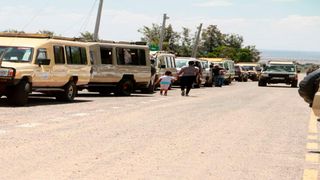
Convoys of vehicles at the Sekinani gate, bringing in diplomats and domestic tourists on Friday July 30, 2020 to watch the Wildebeest migration in the Maasai Mara game reserve.
| George Sayagie | Nation Media GroupNarok
Premium
Maasai Mara emerges from Covid-19 cloud as tourists trickle in
The mating season for millions of wildebeest is under way after the epic crossing of the Sand River from Northern Serengeti to the Maasai Mara game reserve started on Monday afternoon.
The migration is, for the second year running, low key as the traditional hordes of tourists, filmmakers and photographers are not present due to Covid-19.
The movement of oryx and white-bearded wildebeest or gnu at the Sand River crossing was witnessed only by local tour guides and drivers with just a handful of domestic tourists and international photographers.
The spectacle will continue for a week as millions of the gnus graze along the river -- the border of Kenya and Tanzania and cross over to the Maasai Mara.
The three-month stay in Kenya from July to October will be characterised by drama as the gnus mate. Hundreds will be hunted down and killed by predators. There will be stampedes and the breath-taking crossing of the crocodile-infested River Mara as herds migrate west of the Mara towards the Mara Triangle and back.
“This is also the rut period for the wildebeest as they go into the mating season, the Mara is like their bedroom and Serengeti is their maternity where they go for calving of more than 8,000 young daily around February every year. The calves are usually in the herds to the Mara, with many of them killed during the crossing by predators,” said Mr Daniel Karino, a seasoned tour guide in the Mara.
Epic crossing
Speaking to the Nation near the Salas Camp crossing point, Mr Karino, who is also a wildebeest movement monitor, said between April and June, the herds slowly start to move out of the Serengeti as the grass gets depleted. When the rains end in May in the Serengeti, the land dries up fast and the grazers must move on, heading for their dry-season refuge in the Mara.
The herds can be seen around the Seronera and Ikoma area as they move into the Ikorongo game reserve in Tanzania. During this period, they will cross the crocodile infested River Gurumeti. Here one can witness the epic crossings as the crocodiles hunt the wildebeest.
Wildebeests run across a sandy riverbed of the Sand River as they arrive into Kenya's Maasai Mara National Reserve from Tanzania's Serengeti National Park during the start of the annual migration July 18, 2020.
In the Mara, the herds migrate north of the Mara Triangle, crossing into the paradise plains north of the River Mara, towards Talek and Sikinani, into Mara North, Nashulai and neighbouring conservancies outside the 1,510 square kilometres of the protected savanna.
The wildebeest migration was named among the eight natural wonders of the world. It happens every year as thousands of animals gather at the river's banks before plunging into the water to cross over in search of pasture.
Each year, hundreds of the wildebeests die in the stampede. Some simply drown, while others are snatched by crocodiles.
In the last one year or so, as most of the world’s inhabitants were shut indoors, some species got the breathing space to roam freely. Wild animals in national parks were left alone.
Last year, the migration gave a boost to tourism after Covid-19 travel restrictions were limited.
Every year, the Maasai Mara, known for its large population of lions, leopards, cheetahs, elephants and millions of herbivores, hosts more than 300,000 domestic and international tourists that earn the Narok County government more than Sh2 billion in revenue through gate fees. That revenue has shrunk to less than 10 per cent in the past one year.
“Currently, the hotels, lodges and tented camps in the Mara have no visitors, compared to rates of between 90 per cent and 100 per cent during the normal tourist peak season,” said the game reserve's chief warden James Ole Sindiyio.
Twin migrations
The Twin Migrations; The Wildebeest Migration from July through to October happens at the same time as the Humpback Whale migration in Watamu.
Watamu humpback whale watching was started in 2012 by the Kenya Marine Mammals Network, the conservation Watamu Marine Association, Turtle Bay Resort, Hemingway’s resort, Ocean Sports Resort and government agencies.
The crossing of the gnus comes as hoteliers in the Maasai Mara are optimistic about the industry bouncing back with the increased number of bookings expected this month from both domestic and international tourists.
Keekorok Lodge manager James ole Pere was hopeful as several lodges have received bookings from international tourists and they are expecting the “magic number of 50 per cent” bed occupancy by mid this month.
One of the good indicators of the hospitality industry bouncing back, according to Mr Pere, is tour companies that has not been in operation for more than a year, such as Pollmans, Somak and Rhino Safaris, who handle big organised safaris and long tour circuits in Kenya and across East Africa, have started operations and are already taking clients to the Mara.
Mr Pere, who is also in the Mara Serengeti Ecosystem Hotel Managers’ Forum, said for the past one month, the Mara has received unlikely customers who don’t fall under the traditional markets. They include tourists from countries in Eastern Europe such as Belarus, Ukraine and Russia, among others, and Iran, which is a good sign of recovery.
“We are also receiving bookings for the traditional markets, in Europe, America, France but they are yet to receive any from the Chinese and Far East markets,” he added.
Speaking to the Nation in Narok, Mr Pere said airlines that operate in the Mara -- Safari link and Air Kenya -- have started to increase the number of flights to the Mara to twice a day, with one of the biggest aircraft operating in the Mara – from Dutch Air, which has not operated flights for more than a year, starting morning and afternoon flights.





